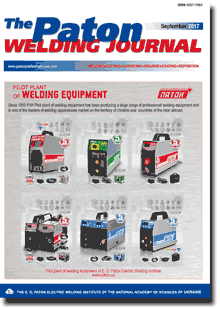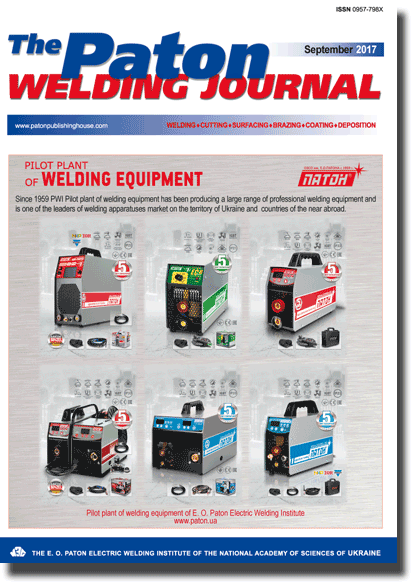| 2017 №09 (03) |
DOI of Article 10.15407/tpwj2017.09.04 |
2017 №09 (05) |

The Paton Welding Journal, 2017, #9, 18-26 pages
Features of the structure of plasma-arc coatings produced at application of flux-cored wires with a steel sheath and filler from B4C AND ZrO2 nanopowder
G.M. Grigorenko, L.I. Adeeva, A.Yu. Tunik, V.N. Korzhik and L.M. Kapitanchuk
E.O. Paton Electric Welding Institute, NASU 11 Kazimir Malevich Str., 03150, Kiev, Ukraine. E-mail: office@paton.kiev.ua
Abstract
Features of the structure of coatings made by high-speed plasma-arc spraying of wire with a steel sheath and B4C powder filler with addition of nanosized ZrO2 powder were studied. Coatings with low porosity (about 1 %), lamellar structure and high hardness were produced on a low-carbon steel substrate. Processes of interaction, running in plasma-arc spraying between the sheath, making up 90 wt.% of the wire, and the filler, were analyzed. Ferrite matrix of the coating is alloyed with boron and carbon, and contains an amorphous phase. It is strengthened by dispersed carbide, borocarbide and oxide particles. Addition of 0.5 % of ZrO2 nanopowder promotes refinement of the coating structure with formation of dispersed borocarbides Fe3(B, C), Fe(B, C)2, and oxides of iron FeO and boron B3O5. Coating microhardness reaches 6.86 GPa that is 4 times greater than that of the ferrite sheath. Coatings of this class can be applied as wear-resistant ones for protection of equipment from gas-abrasive wear in chemical engineering, in manufacturing parts of pumps, compressors and other items, as well as reconditioning worn parts. 22 Ref., 7 Tables, 7 Figures.
Keywords: plasma-arc spaying, flux-cored wire, carbide filler, nanopowders, phase transformation, lamellar structure, dispersed strengthening of coatings, iron boro-carbide, microhardness
Received: 07.04.17
Published: 10.10.17
References
- Khromov, V.N., Vertsov, V.G., Korovin, A.Ya. et al. (2001) From subsonic to supersonic spraying of coatings in restoration and strengthening of machine parts (Review). Svarochn Proizvodstvo, 2, 39–47.
- Kharlamov, Yu.A. (2000) Thermal spraying of coatings and ecological compatibility of production, service and repair of machines. Tyazholoe Mashinostroenie, 2, 10–13.
- Wielage, B., Rupprecht, C., Pokhmurska, H. (2011) Peculiarities of thermal spraying of coatings using flux-cored wire (Review). The Paton Welding J., 10, 21–25.
- Kharlamov, M.Yu., Krivtsun, I.V., Korzhik, V.N. et al. (2007) Mathematical model of arc plasma generated by plasmatron with anode wire. Ibid., 12, 9–14.
- Kharlamov, M.Yu., Krivtsun, I.V., Korzhik, V.N. et al. (2011) Heating and melting of anode wire in plasma arc spraying. Ibid., 5, 2–7.
- Wielage, B., Rupprecht, C., Bruhl, M. et al. (2008) Thermisches Spritzen — Potentiale, Entwicklungen, Maerkte. Thermal Spray Bulletin, 1, DVS-Verlag, 30–36.
- Petrov, S.V., Karp, I.N. (1993) Plasma air-gas spraying. Kiev: Naukova Dumka.
- Kudinov, V.V., Bobrov, G.V. (1992) Spraying deposition of coatings. Theory, technology and equipment. Moscow: Metallurgiya.
- Kharlamov, M.Yu., Krivtsun, I.V., Korzhik, V.N. et al. (2011) Formation of liquid metal film at the tip of wire-anode in plasma-arc spraying. The Paton Welding J., 12, 2–6.
- Borisov, Yu.S., Koziakov, I.A., Korzhik, V.N. (1996) Structure and properties of thermal coatings produced using flux-cored wires of Fe–Cr–B, Fe–Cr–B–C system. Svarka, 5, 21–24.
- Pokhmursky, V.I., Student, M.M., Gvozdetsky, V.M. et al. (2011) Flux-cored wires of FMI series for coating deposition by electric arc spraying (Review). Ibid., 9, 44–48.
- Korotaev, A.D., Borisov, D.P., Moshkov, V.Yu. et al. (2005) Nanostructured and nanocomposite superhard coatings. Mesomech., 8(5–6), 93–104.
- Vityaz, P.A., Ilyushchenko, A.F., Khejfets, M.L. (2011) Technologies of structural nanostructured materials and coatings. Ed. by P.A. Vityaz. Minsk: Belarus. Navuka.
- Makarenko, G.N., Marrej, E.V. (1975) Hard materials based on boron carbide. High-temperature carbides. Kiev: Naukova Dumka, 133–136.
- Panasyuk, A.D., Fomenko, V.S., Glebova, G.G. (1986) Resistance of nonmetallic materials in melts: Refer. Book. Kiev: Naukova Dumka.
- Serebryakova, V.I., Neronov, V.A., Peshev, P.D. (1991) High-temperature borides. Moscow: Metallurgiya.
- Grigorenko, G.M., Borisova, A.L., Borisov, Yu.S. et al. (2003) Investigation of interphase interaction of ferrotitanium with boron carbide in powder mixtures for thermal coating deposition. Sovremennaya Elektrometallurgiya, 1, 28–31.
- Tkachenko, V.F., Kogan, Yu.I. (1978) Peculiarities of structure and mechanical properties of sintered materials Fe–B4 Poroshk. Metallurgiya, 5, 69–71.
- Nevar, N.F., Fasevich, Yu.N., Senkov, V.M., Pavlovich, G.V. (2005) Boron-containing alloy, its characteristics and industrial application. Litiyo i Metallurgiya, 2–2, 174–178.
- Korzhik, V.N., Korob, M.F. (2012) Mechanized line PLAZER 30PL-W for plasma-arc wire spraying of coatings. Svarshchik, 86(4), 13–16.
- Grigorenko, G.M., Korzhik, V.N., Adeeva, L.I. et al. (2016) Specifics of metallurgical processes in plasma-arc spraying of coatings produced from flux-cored wire with steel sheath and fillers B4C and B4C + ZrO2. Visnyk PDTU. Tekhnichni Nauky, 32, 125–138.
- Chien, C.L., Musser, D., Gyorgy, E.M. et al. (1979) Magnetic properties of amorphous FexB100-x(72 ? x ? 86) and crystalline Fe3 Phys. Rev. (Condens. Matter), 20(1), 283–295. https://doi.org/10.1103/PhysRevB.20.283
Suggested Citation
G.M. Grigorenko, L.I. Adeeva, A.Yu. Tunik, V.N. Korzhik and L.M. Kapitanchuk (2017) Features of the structure of plasma-arc coatings produced at application of flux-cored wires with a steel sheath and filler from B4C AND ZrO2 nanopowder. The Paton Welding J., 09, 18-26.The cost of subscription/purchase order journals or individual articles
| Journal/Currency | Annual Set | 1 issue printed |
1 issue |
one article |
| TPWJ/USD | 384 $ | 32 $ | 26 $ | 13 $ |
| TPWJ/EUR | 348 € | 29 € | 24 € | 12 € |
| TPWJ/UAH | 7200 UAH | 600 UAH | 600 UAH | 280 UAH |
| AS/UAH | 1800 UAH | 300 UAH | 300 UAH | 150 UAH |
| AS/USD | 192 $ | 32 $ | 26 $ | 13 $ |
| AS/EUR | 180 € | 30 € | 25 € | 12 € |
| SEM/UAH | 1200 UAH | 300 UAH | 300 UAH | 150 UAH |
| SEM/USD | 128 $ | 32 $ | 26 $ | 13 $ |
| SEM/EUR | 120 € | 30 € | 25 € | 12 € |
| TDNK/UAH | 1200 UAH | 300 UAH | 300 UAH | 150 UAH |
| TDNK/USD | 128 $ | 32 $ | 26 $ | 13 $ |
| TDNK/EUR | 120 € | 30 € | 25 € | 15 € |
AS = «Automatic Welding» - 6 issues per year;
TPWJ = «PATON WELDING JOURNAL» - 12 issues per year;
SEM = «Electrometallurgy Today» - 4 issues per year;
TDNK = «Technical Diagnostics and Non-Destructive Testing» - 4 issues per year.


